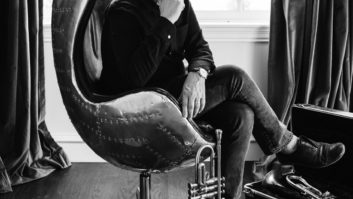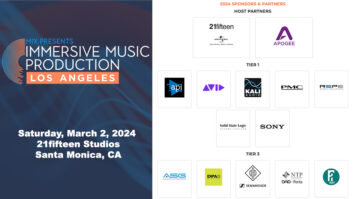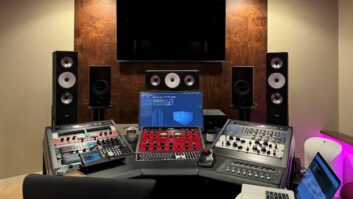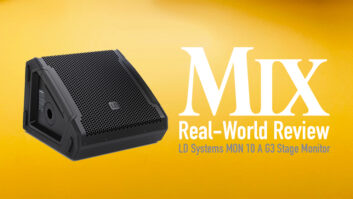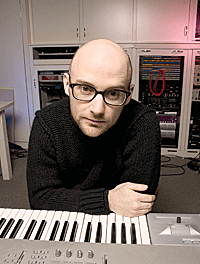

Atrue musical chameleon, Moby has made a career out of defying categorizations and expectations. Is he techno? Punk? A rock ‘n’ roller? A glorified DJ? An ambient chill-out dude? Synth titan or guitar hero? Underground or mainstream? He sampled Twin Peaks composer Angelo Badalamenti on his first hit, “Go,” in 1991 and, as incongruously, blues singers from Alan Lomax field recordings on his multi-Platinum masterpiece Play in 1999. He’s deconstructed the James Bond theme and covered songs by Mission of Burma and New Order. He’s done remixes for Michael Jackson, Pet Shop Boys, Erasure and others. His last two major tours, dubbed Area:One and Area:Two, were as eclectic as he is, with the artist topping bills including David Bowie, The Roots, Paul Oakenfold, OutKast, Incubus, Nelly Furtado, D.J. Tiesto and Busta Rhymes. He’s been criticized for wearing his politics on his sleeve — what Moby article would be complete without mentioning that he’s an outspoken left-wing vegan Christian peacenik animal rights activist? And don’t forget the complaints about him selling every track on Play to various commercial interests — how dare he?
photo: Berry Behrendt
I don’t care about any of that stuff. I think he consistently makes fascinating and varied albums that speak to the soul in beautiful and mysterious ways. His latest, Hotel (set for March 22 release), is no exception. The two-CD set features one disc that is dominated by relatively straightforward pop/rock tunes with electronica shadings, and a second disc of gorgeous, moody, ambient instrumentals. The pop songs pick up where the hit “We Are All Made of Stars” left off: After years of sampling singers and hiring others to do the heavy-lifting live, Moby has blossomed into a confident and distinctive vocalist, with an uncanny knack for writing soaring melodies and infectious hooks that he couches in smart, deceptively simple arrangements that are actually quite complex.
Disc one of Hotel is essentially a “song” cycle about a relationship, covering broad emotional terrain from the first flush of attraction and the exhilaration of mutual chemistry, to carnal come-ons and even disconnected, post-verbal, post-coital bliss. As is usually the case, Moby plays all of the instruments, save for some drumming by Scott Fassetto. Laura Dawn, a longtime friend of Moby’s (and creative director of moveon.org), is his vocal foil this time around. Most of the recording took place in Moby’s sleek (but small) Manhattan home studio, which was designed by Richie Bittner and Marty Strauss to put a vast array of instruments, outboard gear and computers conveniently at the owner’s fingertips. Keyboards are in drawers on modular, mobile sliding racks; I/O connectors and cabling are color-coded for easy use; computer monitors — for Pro Tools, Cubase and film/video scoring applications — are laid out for maximum ergonomic viability. This is a man who spends a lot of time in the studio.
I caught up with Moby by phone at his studio in mid-January for a conversation about his recording techniques, particulars of making the new album and a few other interesting tidbits. As you might expect from listening to his music, he was warm, open and engaging.
You once described recording as “an intuitive craft.” I wonder how it has changed for you during the years, as technology has advanced and you’ve learned more about making records.
I think when I was talking about it being intuitive, what I was referring to was having a home studio. One of the nice things about working at home is you become so familiar with your equipment and your setup that if you want a certain sound, you don’t really have to think about how to accomplish it; you do it almost instinctively.
But how recording has changed! The first recordings I ever made were with a home mono cassette recorder I borrowed from my grandfather when I was 10 years old. I think my first-ever recording was the sound of my mother chopping a cucumber. It turned out really well. When I was 16 or 17, I borrowed a friend’s Tascam 4-track Portastudio, and at the time, I thought that was the coolest thing in the world. Then, when I was 18 or 19, I bought my own Portastudio.
I think people forget what an important invention that was. It really was the gateway for so many musicians to get into recording.
That’s true. To suddenly have the ability to record on multiple tracks at home…and bouncing — I used to bounce tracks like crazy so you’d end up with this terrible-sounding mess [Laughs] but you had nine or 10 tracks on there and it was a fun way to record. I still have hundreds and hundreds of songs that were recorded on the Portastudio.
After that period, I had a combination of a Portastudio with a MIDI setup. My first MIDI setup was an Alesis sequencer with a Casio keyboard and an Alesis drum machine. That Alesis sequencer was really fun; especially for playing live, it was great to be able to manually punch tracks in and out. That was probably the mid-’80s. Then in the early ’90s, I finally made the switch to using a computer and got into using [Steinberg] Cubase.
I know that through the years you’ve primarily recorded in your own home studio, but have you also spent much time in conventional recording studios?
Sure, especially on this new record. I’d say about three-quarters of it was recorded at home. I did all of the electronic stuff at home and the vocal at home. But we recorded the live drums at Electric Lady [New York City] and most of the guitars and some other things were done at Loho Studios on the Lower East Side. We mixed at Electric Lady, as well. We recorded everything on Pro Tools, but we mixed onto half-inch tape.

Moby recorded most of his new album, Hotel, at his ergonomically correct home studio.
Loho is a Neve room, right?
Yes, they have this great Frankenstein Neve that has parts from four or five different Neves cobbled together.
What do Electric Lady and Loho have that your own studio doesn’t have? Is it the live space??
Right, great live rooms and fantastic-sounding microphones. Especially for mixing, too…mixing in Pro Tools is fine — if you don’t care too much.
What do you mean?
I love Pro Tools, but I personally don’t like recording and mixing in the digital domain. There’s something you get being able to go through an analog desk that I really love. We mixed all of this on an SSL J Series at Electric Lady. Obviously, I love plug-ins, but I think they’re best for special effects; I don’t like them much for compression and EQ and things like that. They just don’t sound as good to me as the onboard EQ on an SSL or a Neve, or as good as outboard EQs. As time has passed, I use plug-ins less and less. Again, I mainly use them for special effects — creating sounds you could never create in the analog world. Some plug-ins are nice, but a lot of them sound sort of thin to me.
There are some really gorgeous, fat guitar textures on the new album.
The guitars were recorded through a Matchless amp, I believe. It was owned by the guy who engineered and mixed the record with me, Brian Sperber.
What guitar did you mostly use?
I have this crappy old guitar; I don’t even know what it is. Let me go look…Oh yeah, it’s this Carlo Robelli $180 guitar. Actually, it sounds pretty good. Years ago, when I was touring and breaking a lot of equipment, I developed this ethos of buying the cheapest equipment I could find so when I broke it I wouldn’t care.
I could’ve sworn I heard a Les Paul in there somewhere.
You did. Brian had a gold-top Les Paul that we used, as well. There was also a really nice acoustic guitar, and Brian set up this complicated miking system with a Neumann over the body and something else on the neck. It ended up sounding really good.
Were you familiar with Brian’s work through the years? I know he worked with Patti Smith, Guided By Voices, Orbital…
I’d seen his name cropping up on a lot of different records, either engineering or producing. We worked together fantastically. It helps, too, that we live in the same neighborhood. He’s obviously very good at what he does and very meticulous, which is good because I tend to be kind of lazy. It’s nice to have someone focusing on the guitar being in tune and everything sounding good. I like making good-sounding records and I like good performances, but I guess I’m of the old school because I really can’t think of too many parts that require being played more than two or three times. Brian told me about working with other bands that do things like spend a week working on one guitar part. That doesn’t interest me. I mean, you go back and listen to an old Rolling Stones record and it sounds like it was written and recorded in about 20 minutes.
There’s a really nice cohesion and continuity to the record. The songs flow together well sonically and thematically — one seems to lead into the next in a thoughtful way. I’m assuming most of the songs were written around the same time rather than being from different periods.
That’s right. I think some of that continuity and cohesion you’re talking about is accomplished, hopefully, through the sequencing of the record, which is something I really spend a lot of time on. I can work fairly quickly writing and recording a song, but actually finishing the record and deciding what should be included and what the order should be can take months.
On the new album, a song like “Beautiful” has so much going on. I hear at least three acoustic guitar lines — left, center, right — two electric guitars, drums, electronic rhythm, keyboards, all sorts of vocals. How would you typically construct a song like this? Is it something you would’ve demo’d on, say, an acoustic guitar and then built from there?
Yes, I wrote it on acoustic guitar and then I recorded a version at home with guitars through Amp Farm and then re-recorded everything [at Loho] and added live drums. This record, from a production perspective, was a lot different than records I’d made in the past.
How so?
Part of it was influenced by some Michael Jackson remixes I did years ago: “Thriller”; things that Quincy Jones produced. Those were 48 tracks and I was really impressed with the way the sounds were recorded and the fact that so much was doubled and tripled. Then I was reading an old interview with [Cars and Queen producer] Roy Thomas Baker and he was talking about layering and layering. So I figured with Pro Tools and a huge SSL board you can do that and you don’t have to use the layers if you don’t want to. So on all the “big” songs on [Hotel] — things like “Beautiful,” “Raining Again,” “Lift Me Up” — it’s tons and tons of layers. I have three kick drums, three snare drums. There are probably about 30 background vocals on those songs, four or five acoustic guitar parts, six electric guitar parts, seven or eight stereo string pads.
Moby goes nuts!
A little. [Laughs] I put it all in there so that when we were mixing, rather than taking, say a single low-end synth sound and giving it bite [through processing], it makes more sense to record the exact same string part with a different patch that has the bite you want. And when you need high end, you bring up the string patch that has high end built into it naturally.
That must’ve made the mix a little nightmarish, no?
No, it actually came together really nicely. On paper it might sound excessive to have so much stuff in there, but it wasn’t gratuitous because everything was serving a purpose and there wasn’t the ego of, “Oh, I have to record this perfect lead guitar and make it as loud as possible.” Everything was in service of making the songs as nicely produced as possible. I know some people go crazy with all the options they have in Pro Tools, but I had a clear idea of what the music should sound like so it didn’t feel to me like I had “extra” parts; I needed them. Songs like “Beautiful” and “Spiders” I think are about 96 independent audio tracks. But even if there are 20 or 30 background vocals, they’re mixed so they give you a sense of space and don’t draw too much attention to themselves.
What is your primary string synth?
I use a lot of them. Some of the big string parts are a combination of an old Roland F5080, an old Yamaha SY-22 and this Pro Tools plug-in called Atmosphere that’s really big-sounding. I can get pretty much anything I want from those three.
What arrangers have influenced how you use string sounds? There are so few hip ones from the rock world — Tony Visconti, Paul Buckmaster…
A lot of it is just taking a real simple approach. Like if I’m using a G-major chord, I would probably leave the fifth out and focus on the root and the major third. I like the strings to have an emotional quality but still maintain that sense of space, without getting claustrophobic. Angelo Badalamenti [of Twin Peaks fame] approached his strings that way.
There’s a natural simplicity to the chord progressions you write. They move in logical ways and you can sort of feel how they’re going to go, both in your pop tunes and in your ambient work.
I can see that. When I first started playing music, when I was nine or 10 years old, I had a guitar teacher who only liked complicated music. His criteria for evaluating music was, “How difficult is it?” If it was difficult, it was good; if it was simple, it was bad. And for a few years, I tried to go along with that so I’d listen to Larry Carlton and all this complicated music, and the truth was, I didn’t like it very much. Then I discovered punk rock and I had this epiphany that simple songs played simply can be a lot more effective than really complicated songs. Then, maybe 10 years ago, some friends and I started a cover band and it was playing in that band and seeing how other people write songs that made me realize that the majority of great classic songs are painfully simple. Look at [Lynyrd Skynyrd’s] “Sweet Home Alabama” or [Lou Reed’s] “Walk on the Wild Side.” I can’t count the number of great songs that have two or three chords to them.
You’ve said that all the music you write — whether it’s instrumental, based around vocal samples or whatever — is very personal. But when you come up with a set of songs like this batch — you singing your lyrics — do you feel more emotionally exposed?
Yeah, and it used to make me very uncomfortable. But as time has passed, I’ve developed this strange comfort with being vulnerable and emotional in front of strangers. It used to make me profoundly uncomfortable. There’s also the notion that when you’re writing these emotional songs, you have to, on one hand, care about how people are going to respond, but on the other, you have to say, “If people hate this or hate me because of it, that’s too bad because I can’t completely base my self-worth on the opinions of strangers.”
Are there any producers whose work influenced the sound of your album? There are some touches that remind me of Tony Visconti’s work on the great Bowie albums of the ’70s or the ones he did with T-Rex — like the way he used Flo & Eddie for backing vocals on
Electric Warrior
and
The Slider.
Yep. Some of the songs [on Hotel] are almost paying homage to that sound.
Is “Spiders” one of those?
Very much so, and also “Beautiful.” There’s something about the glam-rock way of producing records — everything is very tight and defined — and to an extent I wanted to incorporate that ethos into some of this record.
Did you like that kind of music at the time?
I was a little too young to “get” glam rock too much. I liked what I heard on the radio — The Sweet and Marc Bolan, and whatnot.
As for other producers, obviously one of my biggest influences would be Brian Eno, from producing the Bowie records, to My Life in the Bush of Ghosts, to U2, to Devo, to the Talking Heads.
Eno is where I probably heard ambient music for the first time. I used to lie with my head between the speakers listening to Discreet Music over and over back in the mid-’70s.
I remember buying Ambient 4: On Land and thinking it was just amazing — taking these non-musical sounds and making something very musical and powerful with it was very interesting.
Tell me about how
Hotel
and the
Hotel Ambient
disc intersect. Were you making these two discs at the same time?
Yes. As far as ambient music goes…I just love really quiet, bucolic, melodic music. And the nice thing about working on the ambient music is that most of it is really simple.
Not 96 tracks.
Oh, no. Toward the end of the ambient disc, there’s even a song that has two tracks, I think. It was almost kind of like a palate cleanser for me. If you’re spending your days recording tons of tracks for more conventional songs, it’s nice to then go home and work on more quiet atmospheric music. I’m not sure if there’s actually any thematic relationship between them. It was more like show-and-tell: I’ve made these two records I like and I’m going to put them out together and see what happens.
Any thoughts on turning 40 later this year?
Hmmm. Well, one thought is that there’s an epidemic in New York and probably in a lot of big cities where people get to a certain level of success and then they continue working and driving themselves crazy even though they don’t need to. So my hope for the future is that I’m not one of those guys who’s 55 years old and having a triple-bypass and peptic ulcers and screaming at your assistant. I see so many people who are making tons and tons of money and they still wake up every day angry. I’d much rather wake up and go ride my bike and play with dogs and write music.
So much of your music has that sort of optimism to it.
Well, when I make records, I want to make them so that people can find a place for them in their lives. I like the idea of records that are warm and inviting.
Do you have a sense on how this record will be received? I guess “We Are All Made of Stars” was pointing in this direction, but I think a lot of people might be surprised by how song-oriented the album is.
I’m sure there are some people who are going to think it’s too commercial. There’s a whole underground music world that for the most part has very little interest in what I do. And that’s okay.
You served time in that world!
I did. But I don’t want to be 39 years old and vying for the attention of a 21-year-old indie rock journalist. They have their own world, and I really like the music that comes out of that world, but it would be disingenuous for me to suddenly make a really obscure indie rock record. I love the music, but it’s not where my heart is creatively.
Blair Jackson is Mix’s senior editor.

More great interview footage from Blair Jackson’s interview with Moby wound up on the cutting room floor. Click here for the scoop.
Click here to listen to an MP3 clip of “Beautiful,” from disc 1 of Moby’s forthcoming CD, Hotel.
